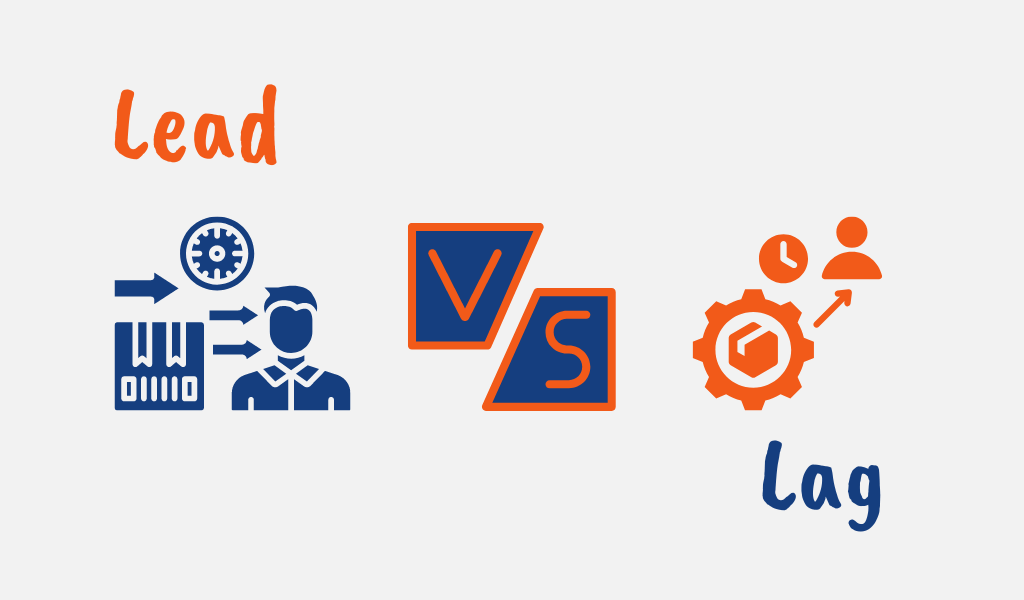Leads and lags are two vital concepts in project management that you need to fully grasp and utilize for executing successful projects as they significantly impact project schedules.
Projects are temporary endeavors that are time-constrained, and designed to create value for attaining goals. For a project to be deemed successful, it has to be delivered within the planned schedule.
An effective way of optimizing project timelines, allocating resources efficiently, and ensuring projects stay on schedule is by mastering and use of leads and lags.
This comprehensive guide will help you understand the differences between leads and lags, how they apply to various project scenarios, and best practices for using them effectively in your project planning.
Lead vs Lag: Overview
What is Lead in Project Management?
A lead in a project refers to the time advantage one activity has over another when they are in a finish-to-start relationship.
In this context, a lead allows an activity to start before its predecessor activity is completed, essentially enabling parallel execution of tasks and optimizing the project schedule.
What is Lag in Project Management?
In project management, a lag refers to the amount of time that must pass or the intentional delay between the completion of one activity and the start of a subsequent dependent activity.
Lags are used to create a buffer or waiting period between tasks to account for factors like resource availability, external dependencies, or other constraints within a project.
Lags are often used in conjunction with leads to fine-tune the project schedule and ensure that dependencies between tasks are properly managed.

Difference Between Lead and Lag in Project Management
While lead and lag are essential components of project management that influence project scheduling, they serve different purposes and have distinct implications for project success.
For a proper understanding of these concepts, you need to understand dependencies in project management which is the relationship between sequenced tasks.
To better understand their roles, we can compare them using various aspects:
1. Definition
Lead is the amount of time by which a successor activity can start before its predecessor activity has been completed.
In other words, it allows activities to overlap, effectively shortening the overall project duration.
Lag on the other hand is the intentional delay between the start or finish of one activity and the start or finish of its successor activity.
It represents a waiting period that needs to elapse before the dependent activity can begin or end.
2. Purpose
The main purpose of using lead is to accelerate the project schedule by allowing parallel execution of activities that do not have strict dependencies to help optimize resource utilization and reduce the total time required to complete the project.
Lag, on the other hand, is used in project management to account for external factors or constraints that prevent activities from starting immediately after their predecessors have been completed.
They can also be used to represent mandatory waiting periods, such as the time required for concrete to cure or for approvals to be obtained.
3. Application
Leads are typically applied when the relationship between activities is “Finish-to-Start” (FS), meaning that the successor activity can start before the predecessor activity has finished.
For example, if painting a wall can start when 50% of the wall is prepared, a lead of 50% can be applied to the painting activity.
Lags however can be applied to any of the four types of dependency relationships in project management: Finish-to-Start (FS), Start-to-Start (SS), Finish-to-Finish (FF), and Start-to-Finish (SF).
For example, a lag of three days in an FS relationship means that the successor activity must wait three days after the predecessor is finished before it can begin.
4. Impact on Project Schedule
Incorporating lead can improve the project’s schedule performance, but it may also increase the risk of rework or errors if activities are started before their predecessors are adequately completed.
Careful consideration must be given to the feasibility and practicality of overlapping activities.
On the other hand, adding lags to a project’s schedule can result in longer project durations, as activities may be delayed due to waiting times.
However, they are necessary to accurately represent real-world constraints and dependencies, ensuring that the project schedule is realistic and achievable.
5. Impact on Project Efficiency
Reducing lead time can directly improve project efficiency, as shorter lead times ensure tasks are completed more quickly and resources are used effectively.
In contrast, lag time does not contribute to project efficiency or productivity. Instead, it helps mitigate risks and allows the project to adapt to changing circumstances.
6. Calculation
Lead time is calculated by considering the duration of tasks and their dependencies.
For instance, if Task A takes three days and Task B takes two days but can only start after Task A is finished, the total lead time is five days.
Lag time, however, is determined by the time required to meet specific conditions before the next task can start, such as resource availability or external dependencies.

Example of a Lead in Project Management
Let’s consider a simple example to better understand what a lead is in project management.
Suppose you are managing a software development project, and one of the tasks is to design the user interface (UI) for the application. The UI design task has an estimated lead time of 10 days.
At the same time, the development team can start working on the backend functionality of the software.
However, they will need some UI components to be available before they can fully integrate the frontend and backend.
To optimize the schedule, you decide to give the backend development a lead of 5 days, which means they can start working on their task 5 days before the UI design task is expected to be completed.
In this example, the lead between the UI design and backend development tasks is 5 days. By introducing the lead, you enable the backend development team to start working on their task sooner, potentially shortening the overall project duration.
Example of Lag in Project Management
Let’s continue with the software development project example from before.
Suppose that after the user interface (UI) design is completed, a third-party vendor needs to review the design and provide feedback. You anticipate that it will take the vendor 4 days to review the design and provide their input.
In this case, you would introduce a lag of 4 days between the completion of the UI design task and the start of the next task that depends on the vendor’s feedback.
This lag allows for the necessary waiting period for the vendor to complete their review before the project can proceed to the next stage.
By incorporating lags into your project schedule, you can account for necessary waiting periods or delays and create a more accurate and realistic timeline for the completion of the project.

How to Apply Lead and Lag in Project Management
Leads and lags can be applied in project management to optimize the project schedule and manage dependencies between tasks more effectively.
Here’s a step-by-step guide on how to apply leads and lags in project management:
- Identify dependencies between tasks: Start by reviewing your project plan and identifying the tasks that depend on one another. This can help you understand the sequence of tasks and their relationships.
- Analyze the project schedule: Assess the project schedule to identify potential areas where leads or lags can be applied. Look for tasks that can be executed in parallel to save time or tasks that require waiting periods due to external dependencies or other constraints.
- Determine appropriate leads: If you identify tasks that can be executed in parallel or partially overlap, consider introducing leads. Analyze the potential time advantage one task can have over another and determine the appropriate lead time to optimize the project schedule.
- Determine appropriate lags: For tasks that require waiting periods or have external dependencies, determine the appropriate lag time. This should be based on the estimated time required for the preceding activity to be completed or the waiting period necessary before the subsequent activity can start.
- Update the project schedule: Once you have identified the leads and lags, update your project schedule accordingly. This may involve adjusting the start and end dates of tasks or modifying the dependencies between tasks to reflect the leads and lags.
- Monitor and adjust: As the project progresses, monitor the actual lead and lag times, comparing them to your initial estimates. If necessary, adjust the leads and lags in your project schedule to better align with the actual progress and constraints encountered during project execution.
- Communicate changes: If you make any adjustments to leads or lags, ensure that you communicate these changes to your project team and stakeholders. This helps maintain transparency and keeps everyone informed about the project’s progress.

Best Practices for Balancing Leads and Lags in Project Management
Balancing leads and lags in project management is essential for maintaining an efficient and realistic project schedule.
Here are some best practices for achieving this balance:
Analyze Dependencies
Before applying leads and lags, thoroughly analyze the dependencies between tasks to understand their relationships and the potential impact of leads and lags on the project schedule.
Determine the Feasibility of Leads
When considering leads, ensure that tasks can be genuinely executed in parallel or partially overlap without compromising quality or causing rework.
Assess whether resources, such as personnel and equipment, are available to support the simultaneous execution of tasks.
Consider External Factors
When determining lags, take into account external factors, such as resource availability, regulatory requirements, and contractual obligations.
Ensure that the lags accurately reflect real-world constraints and dependencies.
Use Leads and Lags Judiciously
Avoid overusing leads and lags, as they can complicate the project schedule and make it difficult to manage.
Use them only when necessary to optimize the schedule or account for constraints and dependencies.
Monitor Progress and Adjust
Regularly monitor the project’s progress and compare actual lead and lag times to your initial estimates.
Adjust the leads and lags in your project schedule as needed to better align with the actual progress and constraints encountered during project execution.
Communicate Changes
If you make any adjustments to leads or lags, ensure that you communicate these changes to your project team and stakeholders.
This helps maintain transparency and keeps everyone informed about the project’s progress.
Validate Your Schedule
After incorporating leads and lags, validate your project schedule by conducting a schedule risk analysis or seeking input from subject matter experts.
This helps you identify potential issues or areas for improvement in your project schedule.
Use Project Management Software
Utilize project management software that supports leads and lags to help you manage and visualize dependencies more effectively.
These tools assist in automatically adjusting project schedules when leads or lags are modified.

Tools and Software for Managing Leads and Lags
Several popular project management software tools support leads and lags, making it easier to manage dependencies and optimize project schedules.
When selecting project management software, it is essential to consider your specific needs and requirements, as well as the size and complexity of your projects.
Evaluate the tools based on their features, integrations, ease of use, and pricing to find the best fit for your organization.
Some of these tools include:
Microsoft Project
Microsoft Project is a widely used project management software that allows you to manage tasks, resources, and timelines.
It supports leads and lags for various dependency relationships and offers a comprehensive set of features for managing and visualizing project schedules.
Smartsheet
Smartsheet is a flexible, cloud-based platform that combines elements of spreadsheets and project management software.
It supports leads and lags and offers features like Gantt charts, resource management, and automation to help manage complex project schedules.
Oracle Primavera P6
Primavera P6 is an enterprise project management solution from Oracle that supports leads and lags and provides powerful scheduling and resource management capabilities.
It is particularly popular in industries like construction, engineering, and utilities, where complex projects with multiple dependencies are common.
ProjectLibre
ProjectLibre is an open-source project management software that serves as an alternative to Microsoft Project.
It supports leads and lags and offers features like Gantt charts, network diagrams, and resource leveling to help manage project schedules.
TeamGantt
TeamGantt is an online project management tool that focuses on Gantt chart creation and collaboration.
It supports leads and lags and offers drag-and-drop functionality for managing task dependencies and timelines.
Clarizen
Clarizen is a cloud-based project management software that supports leads and lags and offers features like resource management, project planning, and real-time collaboration. It is designed for large organizations and enterprise-level projects.
Conclusion
Understanding and effectively applying leads and lags in project management is crucial for optimizing project schedules, managing dependencies between tasks, and ensuring successful project execution.
By mastering these concepts, project managers can allocate resources efficiently, mitigate potential risks, and maintain realistic timelines that align with real-world constraints.
As you continue to hone your project management skills, remember to carefully consider the balance between leads and lags to create more accurate and efficient project schedules that contribute to the overall success of your projects.
FAQs
What is a Key Benefit of Using Lags With Finish-to-Start Relationships?
Using lags with finish-to-start relationships in project management allows more time between sequential tasks. This provides flexibility to account for delays or resource constraints between connected tasks.





